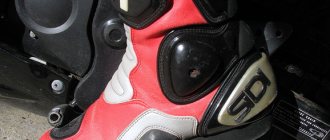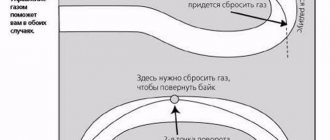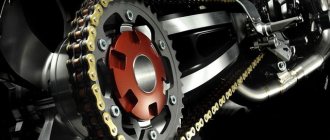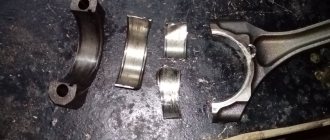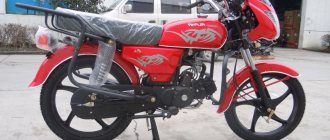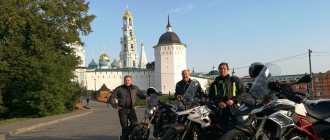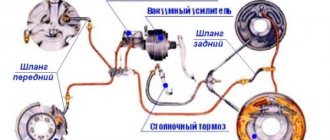About the effectiveness of the front and rear brakes
On asphalt, always and in all cases, the main brake is the front one. It is the most effective both structurally and from a physical point of view. When you start to brake, the motorcycle seems to “nod off”. The front wheel is loading. Its contact area with asphalt increases. While the rear one may even come off the surface (stoppie), and then there will be no braking at all.
This does not mean that the rear brake is not effective and should not be used. By refusing it, you lose up to 50% of your braking force. Two brakes will always be more effective than one!
Normal quiet braking
When riding a motorcycle, there is most often no need to brake urgently. You calmly react to predictable road conditions, calmly approach a traffic light, or slow down before turning. In this case, it is optimal to use the following algorithm:
- Start braking with the rear brake. This will lead to a reduction in speed and loading of the front wheel (improving its grip on the asphalt);
- Smoothly apply the front brake for a controlled stop;
- Depress the clutch even when decelerating strongly, so as not to lose traction on the rear wheel (and therefore control over the motorcycle).
Everything described above and below concerns braking on asphalt or other durable, level surfaces. We’ll talk about deceleration and stopping techniques for enduro, on wet ground and in a swamp, another time.
Normal braking
In a smooth, straight-line motion, the rider-bike system is properly balanced so that the rear wheel's contact patch is slightly larger than the front. During braking, under the influence of various forces, the weight distribution changes, loading the front wheel more. We cover the main braking distance with the front wheel loaded. Thus, the bike's braking potential is realized mainly by the front brake.
If we use only the rear brake, we will get 2 times less effective braking (i.e., the braking distance will increase by about 2 times). This is intuitive for any novice rider. That's why almost everyone always tries to brake with their hands. However, do not forget that in this scheme there is also a place for a foot brake. After all, when we start to brake, our rear wheel is loaded. This means that applying the brake impulse to the rear wheel at the very beginning of braking will allow you to stop more efficiently and safely.
So, in order to brake correctly on a motorcycle you need to:
The pressing force depends on the expected braking distance.
Emergency braking
Motorcycles in city traffic are invisible. Even if you drive in the distant car during the day, drivers still don’t see you. It’s better to always drive with the assumption that you are invisible.
So, what should you do if an obstacle suddenly appears in front of you and your motorcycle does not have ABS? This could be either a car making a maneuver or pedestrians who jumped out in the wrong (or even the right) place:
- At the same time, you begin to work with two brakes - front and rear. Don’t listen to the myths that you need to start with the back first and then supplement with the front. In those seconds you spend on the rear brake alone, you are not using half of the bike's braking potential;
- They may tell you about engine braking. This also does not work in the case of emergency braking. There may be a few seconds left before the obstacle, what gear reduction? All your attention should be directed to reducing the speed as much as possible using the brakes;
- Don’t even think about trying to dodge an obstacle with the brakes pressed - this will lead to a 100% fall. The strategy for avoiding a collision is to slow down as much as possible, then release the brakes and go into the maneuver;
- If the obstacle is pedestrians, no maneuvers! Only braking. Remember that people are playful and jumpy, and no one can guarantee that they won’t jump into you when you try to drive around them.
About the myth about “I put the motorcycle down”
You can often hear a phrase in the style of “I realized that I didn’t have time to brake, so I put the motorcycle down.” It is all a lie, from beginning to end. In an emergency situation, only reflexes and the instinct of self-preservation are triggered. There cannot be any conscious analysis about whether you have time to slow down or not. Therefore, in order for the reflexes to work correctly, it is necessary to regularly practice emergency braking on the site. Many times.
Now about “put the motorcycle down”. Any bike brakes better on two wheels, with rubber adhering to the asphalt, using both brakes - than in an uncontrolled flight on its side, sliding plastic and metal along the road, without any grip on the surface.
- If a fall occurs, you and your motorcycle will fly into an obstacle at the same speed at which you fell;
- If you tried to brake until the last moment, you have a chance to reduce the speed enough to make a subsequent maneuver and avoid a collision, or if you fail to dodge, you will collide with an obstacle at minimum speed, your chances of staying alive and not even getting hurt are increase significantly;
- If there are pedestrians ahead, a bike flying at the same speed on its side crashes into their legs, which leads to multiple fractures and a strong blow to the head on the asphalt, with a wide amplitude. The maximum speed reduced by proper braking, even if it leads to a collision, the consequences will be much less serious, perhaps even just a slight jolt.
Therefore, everyone who says that “I realized that I didn’t have time to brake, and therefore I put the motorcycle down” - stop lying and looking for excuses for yourself. It’s better to enroll in a good motorcycle school, where they will teach you how to brake properly.
How to properly brake the engine on a motorcycle
Hello everyone, this is the Moto Gymkhana Che channel and yes, this is the second part about braking! The first episode collected hundreds of comments, so in the new video we tried to cover the topic in as much detail as possible. During filming, we tested 14 methods of braking with 3 different motorcycles, so make your tea stronger) Text version with pictures, as always, below the cut.
So, the first thing, which is also the main thing you need to remember, is that there is not and cannot be one universal way to brake for all people and all motorcycles. Even for two identical bikes, but with different drivers, the details of the braking process may differ, and further you will understand why. The main message of the video is training, training and more training! You must theoretically know and practically be able to stop from all speeds at which you drive. But now we will figure out how to do this.
You are driving along the road, there are no cars, a red traffic light lights up far ahead. How can you stop? Whatever you want, really! At least with one front brake, at least with a rear brake, at least by downshifting and engine braking, etc. What difference does it make - you are absolutely calm and relaxed, you have a lot of space ahead and there is no need to “stop urgently right now!” But what if it’s still worth it? Well, even here you can afford to remain calm and simply brake as efficiently as possible, the way you are used to. The biggest problems begin when you completely miscalculated the assessment of the road situation and it turned out to be a complete surprise for you, and there is only one thought in your head: “Brake, brake, BRAKE!”
What will happen in such a situation? You will act solely on reflexes, as you are used to doing every day. If you squeezed the clutch in 7 out of 10 everyday braking situations and then braked only with the rear brake, smoothly rolling up to the traffic light, then in an extreme, pre-accident situation, the same thing will happen: you will squeeze the clutch and hit the rear brake. Well, maybe you'll jam the front one out of fear. And then you are guaranteed to fall, with no options. Each of your braking on the road in the most ordinary, non-stressful situations should always be the same as it would be in an extreme situation - not in terms of intensity, you don’t have to brake to the floor every time from 60 km/h and keep within 12 meters - but in terms of technique execution. You decide for yourself what this technique should be, I’ll just try to give some advice.
The first is concentration
If you perform one action - for example, only brake on the front - you can concentrate 100% on that action and perform it very well. If you additionally brake with the rear, you are forced to distribute your attention, and, therefore, you will not brake so well with the front. If you are still pressing the clutch, you are already performing 3 tasks, and if you are also changing gears... How effectively can you brake in this case with the main, front brake? Our task when braking is to perform as few actions as possible and concentrate as best as possible on the main thing - braking with the front brake. Any additional action will distract us and will not allow us to fully concentrate on the main thing. This means that it will not be possible to completely control the deceleration process.
Second - rear brake
Yes, yes, it is with the rear brake that we also need to deal with from the very beginning. How quickly can it stop your bike? How easy is it to block? How much does it help save braking distance? The first thing you should start with is getting out on the lot and getting reacquainted with your rear brake. To begin with, accelerate, squeeze the clutch and try to stop. See how easily the rear wheel locks? Does the bike start to wobble a lot when the rear wheel locks? Are you good at noticing the moment of blocking? What, just the squeal of the tires? Now imagine that the car in front of you is also slowing down, a Kamaz truck is honking in the next lane, and there is a construction site nearby. Will you be able to hear the squeal of your tire in this cacophony? Well, okay, now brake without pressing the clutch. Better? Of course, since the engine continues to rotate the wheel, it becomes more difficult to block it. At the same time, you can understand that the rear brake is pinched not only by the squeal of rubber and the feeling of the rear wheel driving to the side. The sound of the engine will also help, as well as the “beating” on the rear wheel - as if the ABS had worked - because if we do not press the clutch, the engine is connected to the wheel. But there are also disadvantages - in this case the engine may stall, and this is not very good. You will also notice another paradox: while braking, you have to weaken the pressure on the pedal, and not strengthen it - because the weight of the motorcycle moves forward during braking, the rear wheel is unloaded and blocked more easily. Now try to brake simply to the floor, immediately blocking the wheel. The difference in braking distance, by the way, will most likely be very small - but it will be more difficult to keep the bike from spinning and falling. On the Internet you can often find advice to brake intermittently with the rear brake - try it too, and at the same time make sure that this method of braking is completely untenable. I almost flew into the bushes in the video; I had to urgently apply the front brake.
A little theory
In braking a motorcycle, everything is much simpler than, say, putting the motorcycle into a turn. However, some points need to be understood:
- Wheel adhesion to the road is the main factor in the stability of a motorcycle when riding, as well as when performing maneuvers, including using the brakes.
- The area of adhesion between the wheel and the road surface is traditionally called the contact patch of the wheel with the road.
- The larger the contact patch, the greater the braking force that can be realized by the wheel.
- At any given time, the most effective braking will be the one that falls on the busiest wheel.
Braking correctly means using both the rear and front brakes, and remembering to slow down when changing gears.
Emergency braking
Ideally, the sequence of actions should be the same as during normal braking on a motorcycle.
- Rear brake.
- Gear shift -1.
- Squeeze the front brake as hard as possible until the tire of the rear wheel squeaks, but without allowing the front wheel to lock.
- Gear shift -1.
But in reality, even people who have been riding for several days, in an emergency, completely forget about the rear brake and, out of habit, squeeze the front one. In this case, the load is redistributed in such a way that 90% of the weight of the bike-rider system falls on the front wheel. It should be added that emergency braking on a motorcycle always involves instinctively pressing the brake handle sharply. But keep in mind that when braking sharply, the force holding the motorcycle in balance will weaken, as a result you will lose stability and fall.
If you are one of those riders who presses on the front brake in an emergency, then continue to do as you did, but correctly: To stabilize the motorcycle, train yourself to complement the front braking with the rear, i.e. Brake with both brakes alternately. In this case, the front wheel will perform the main braking function, and the rear wheel will help stabilize the bike and correct movement.
How to brake correctly
If the motorcycle speed is 60 km/h, then, when using the rear brake, the braking distance will be 30 m (until a complete stop). When using the front brake, the distance will be reduced by 2 times. With the combined use of the rear and front brakes at the same time, the distance will be 14 m, which is not much better than using only the front brake. With proper use of two brakes, the braking distance will be 13 m (approximate, average data are given, for Japanese classics of medium cubic capacity, on dry asphalt, with a good coefficient of adhesion and may differ on different motorcycles).
The most important thing is to learn to always keep two fingers on the brake. A driver, especially a novice, (in a panic) may not be able to reach it at all. So, how to use the front brake correctly: let off the gas, gradually load the brake, controlling its blocking. If you press the front brake immediately, sharply, the suspension will not have time to load and the wheel will lock faster. When braking with the front brake, the fork is compressed and the center of gravity shifts to the front wheel. If you press the brake sharply, there will still be no weight on the front wheel, i.e. the center of gravity will not have time to shift and the wheel will lock earlier. If the fork is loaded, it is more difficult for the motorcycle to lock the front wheel. With all this, the rear wheel is fully loaded and can even lift off the ground. In this case, the effectiveness of the rear brake shifts to zero. Therefore, it is more correct to start braking with the rear brake, when the rear of the motorcycle “sits” on the suspension, and only after that start using the front brake.
Locking the rear wheel (using the rear brake) will not cause the motorcycle to fall faster than locking the front wheel. When we feel the degree of locking of the rear wheel, then we can evaluate the degree of influence on the front brake lever. We cannot evaluate the quality of road grip, as it depends on the structure of the road surface, heating of the rubber and other factors (water, sand, bitumen, etc.). This is the minimum that you need to know and be able to use when braking on a motorcycle. Next, we will consider the use of the brake in specific situations.
Braking on slippery roads
All the principles described above are fully applicable to situations with poor wheel grip (wet asphalt, sand, etc.).
But there are some features:
- a decrease in the coefficient of adhesion leads to a decrease in the overall braking force;
- the redistribution of the mass of the rider-bike system is insignificant, and this means that the rear wheel, along with the front, continues to have a large contact area with the road.
There are 2 consequences of these features that are worth considering:
- braking distance increases by 3-5 times;
- the rear brake should be applied more.
So, to stop correctly on a slippery road:
- Do not panic.
- Brake with your rear wheel.
- Level the motorcycle.
- Use the rear and front brake to stabilize the motorcycle.
- Brake to the point of locking the wheels.
How to brake correctly on a motorcycle?
Riding a motorcycle, even calmly, always carries an increased risk.
Saving the life of a motorcyclist largely depends on how quickly he learns all the traffic and safety rules. Also, a lot depends on how the motorcyclist brakes on the road; proper braking reduces the occurrence of emergency situations. Since the motorcycle has two wheels, it is quite unstable, so it is important to immediately learn the rules of proper braking. Braking rules should be given great attention. It must be remembered that during sudden braking and stopping, the rear suspension of the motorcycle may ride up, which will lead to an imbalance in weight and increase the load on the front wheel of the motorcycle. The question arises, which wheel is better to brake then?
Advertising: For confident braking, motorcycle rims must be in good working order; it is necessary to repair motorcycle rims on time.
The front brake, especially if it is sharp, usually leads to wheel locking. In this case, the weight is redistributed and there is a possibility of flying forward out of the saddle.
Braking with the rear wheel stabilizes the situation a little and reduces the braking distance.
The braking result largely depends on how well the weight is distributed.
Learning to properly reduce speed until the motorcycle comes to a complete stop is one of the main and basic driving skills that a driver should master as soon as he gets behind the wheel. According to experts, if everyone knew how to brake correctly, there would be significantly fewer accidents on the road.
Why is knowledge about proper braking on a motorcycle necessary?
Many motorcyclists believe that knowing how to brake properly on a motorcycle is as simple as pressing the brake lever. However, this is a very deep misconception. This is due to the fact that the motorcycle has only two wheels. Their grip density on the road is very low. During hard braking, the front fork begins to compress and weight is transferred forward. Every motorcyclist knows such situations. This leads to incorrect braking and troubles along the way.
When braking, every motorcyclist must act with extreme caution while braking. After all, all motorcycles have different braking parameters. Many motorcycle models stop only when the tires on their wheels warm up to a certain degree.
In most cases, motorcyclists make one main mistake while driving when braking. It consists in the fact that they fully squeeze the brake lever, which leads to a sharp blocking of the movement of the rear wheel. The result is a fall or a collision on the road with another participant in the movement.
Motorcycle braking distance
Risks when braking on a motorcycle
In an emergency situation (sudden obstacle, etc.), many drivers become confused and begin to sharply pull the handle and press the pedal to the floor. This may cause the rear wheel to lock, causing the motorcycle to skid. Even if you release the brake, it is difficult to stop the motorcycle. The result is almost always the same - fall.
Before exceeding the permissible driving speed, you should first practice proper braking to get out of emergency situations. This will also not only allow you to avoid an emergency situation on the road, but will also significantly reduce the wear of the main components.
Some of the common mistakes that occur are a slow reaction to the situation, using one brake, severe panic and, as a result, loss of control over the motorcycle. Slow reaction - a person cannot correctly calculate the distance for which he needs to stop. Using only one brake lever, often abruptly, can lead to wheel locking and a fall. Also, as a result of the wheels locking, the driver loses control and begins to panic. All these errors together lead to an emergency situation, and unfortunately, often fatal.
Risks when braking. What could go wrong?
When sudden obstacles arise, many begin to sharply pull the handle and press on the pedal. As a result, the rear wheel can become completely blocked, which leads to the motorcycle skidding . Once you release the brakes, it is already quite difficult to stop the bike. There is only one result: in almost one hundred percent of cases there will be a fall.
Correct braking must be well practiced. This will not only allow you to avoid an emergency, but will also reduce wear on the main components of the motorcycle. Before increasing your driving speed, you should learn how to properly get out of emergency situations.
The risk of braking increases in rain or ice conditions. Reduced friction leads to an increase in braking distance and the risk of losing control of the vehicle. Weather conditions often cause accidents.
The most common mistakes that occur when stopping a motorcycle are being too slow to react, using only one brake, panicking, and losing control of the vehicle. A slow reaction is very often due to the fact that a person underestimates the distance at which he needs to stop, does not take into account the weight of the vehicle and the very small area of contact between the wheels and the asphalt.
Using one brake lever, often abruptly, leads to wheel locking and a fall. As a result of wheel locking, many people lose control and panic. If we add here sudden movements and surface quality, one conclusion arises - the result of such braking can be dangerous.
Correct braking technique on a motorcycle
When riding a motorcycle, there is a high probability of needing an emergency stop. One of the keys to the success of proper braking is the correct position of the motorcyclist. When landing correctly, you need to sit as far as possible from the tank. Rest your knees against the tank, and your arms should be straightened at the elbows.
When braking sharply, the following sequence of actions:
- Turn off the gas completely.
- Smoothly, not sharply, press the rear brake pedal.
Align the motorcycle vertically.
- Take the correct position - moving back as much as possible. This will load the rear fork and allow some balance to be balanced. Place your fingers correctly on the hand lever and your foot on the rear brake.
- Start pressing on the rear brake.
- Try to fully depress the clutch.
- Monitor the pressure on the front and rear control arms.
- If the wheels are blocked, release the brake until the wheel's functionality is restored.
- Remember, any sudden movements are unacceptable.
Also, while braking, you need to have time to analyze how the pads behave, how the wheels adhere to the asphalt (have you chosen the right tires), and pay attention to how the speed changes. You should also choose the best option for how many fingers are more comfortable for you to press on the lever. All these actions will help you if an emergency stop occurs.
Braking on a motorcycle
Almost every modern motorcyclist is well aware that, as with an increase in speed, there is an influence not only on the degree of speed of movement, but also on the distribution of the weight of the motorcycle.
One of the main rules for proper braking on a motorcycle is that it is necessary to press the lever not completely, but gradually. This will allow you to decelerate in the correct manner.
During unexpected situations on the road, when you have to brake sharply, you need to be extremely careful. After there was strong pressure on the lever during heavy braking, it needs to be slightly loosened. This will allow the rear wheel to be released from locking.
